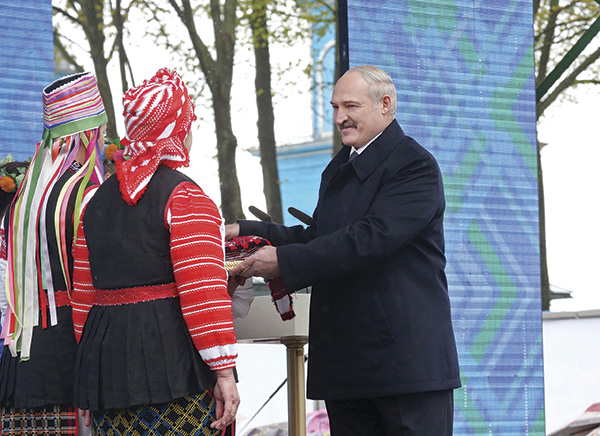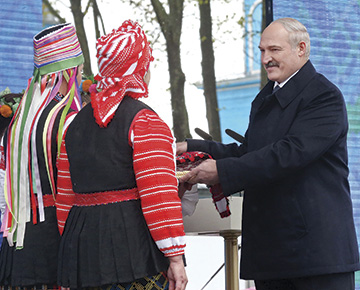
Alexander Lukashenko awarded the ‘Circle of Life’ symbolic rushnik in Yelsk
The accident at the Chernobyl nuclear power plant didn’t occur in Belarus and, although we were in no way to blame, our country took the brunt of the impact: around 70 percent of the radioactive substances fell here. Around 25 percent of Belarus was contained within the affected area. In the first few years after the tragedy, no one knew what to do and where to move to. After the collapse of the USSR, the young Belarusian state was virtually left alone to cope with the Chernobyl disaster. There were many sceptics who predicted the country would fall into chaos. Many brave and determined people have, however, managed to survive the trials; they’ve not only restored the affected lands but turned them into well-kept towns and villages, blooming gardens and arable fields. This is not a metaphor but reality. Moreover, the rehabilitation and development of the affected areas are under the personal control of the President who visits these lands annually. This time, Alexander Lukashenko paid a working visit to the Yelsk District.
Bad weather does not stop the hardworking Polesie residents. Dobryn agro-town is busy with field workers; local villagers were planting corn on the day the President came. Winter crops were already in evidence. Owing to the latest scientific technology, workers in the affected areas have learned to produce meat and milk which are even cleaner than in neighbouring districts. Mr. Lukashenko has encouraged them to use more organic fertilisers instead of chemical additives. Environmentally friendly products are highly valued all over the globe.
A strong industrial base will contribute to social development. Dobryn is an excellent example for many district centres in this respect — a fact appreciated by the President. Mr. Lukashenko is keen to ensure that all agro-towns and especially district centres will look similar to Dobryn in the next five years. Young people will then feel pride in their town and will be less likely to leave. A deep moral sense is rooted in these plans. It would have been a betrayal to leave the land which has been producing food for people for centuries. Of course, it was not easy for the state to revive the regions affected by radiation. Mr. Lukashenko quoted some figures outlining the damage caused to the country’s economy by the Chernobyl catastrophe which is estimated at about $235bn. The international community’s assistance has been and remains small — accounting for around 1-2 percent of Belarus’ domestic spending (which has already exceeded $22bn). This of course is without calculating the immeasurable amount of heroic work done by locals and volunteers.
Fortunately, the people of Belarus did not succumb to panic. According to the state programmes, the systematic work on decontamination, building of sewage treatment plants, thousands of kilometres of pipelines and water supply systems, over a hundred thousand houses and flats, about five hundred schools, kindergartens, health centres and sports facilities is continuing. This policy is a matter of respect — not only for neighbouring Russia and Ukraine; it is studied by many experts from the countries using nuclear technology. For example, the Republican Research Centre for Radiation Medicine in Gomel is visited by American and Japanese doctors — to learn from our experience. Instead of areas covered with weeds, foreign guests are welcomed by wonderful landscapes where people can work and live comfortably. Moreover, they feel safe here and local marriage offices are the best confirmation: they register an increasing number of births. In Dobryn alone, two sets of twins were born last year. This is the best argument in favour of the Government’s policy in rehabilitating the Chernobyl territories. “As I was informed by Vladimir Dvornik [Chairman of the Gomel Regional Executive Committee], your increase in birthrate is 2-3 percent more than the region in general. This means people have decided to live here. In this five-year period, we’ll completely gasify district centres and agro-towns, in addition to major settlements,” the President said.
Participation in the final concert of the Renaissance creative marathon was the final chord of the President’s working visit. Mr. Lukashenko was presented with a symbolic 30 metre ‘Circle of Life’ rushnik — made by weavers from Neglyubka, of the Vetka District. According to them, it will help to protect our country from wars and disasters. Mr. Lukashenko expressed gratitude to the people for their love of our native land and the desire to improve it.
By Yevgeny Kononovich











